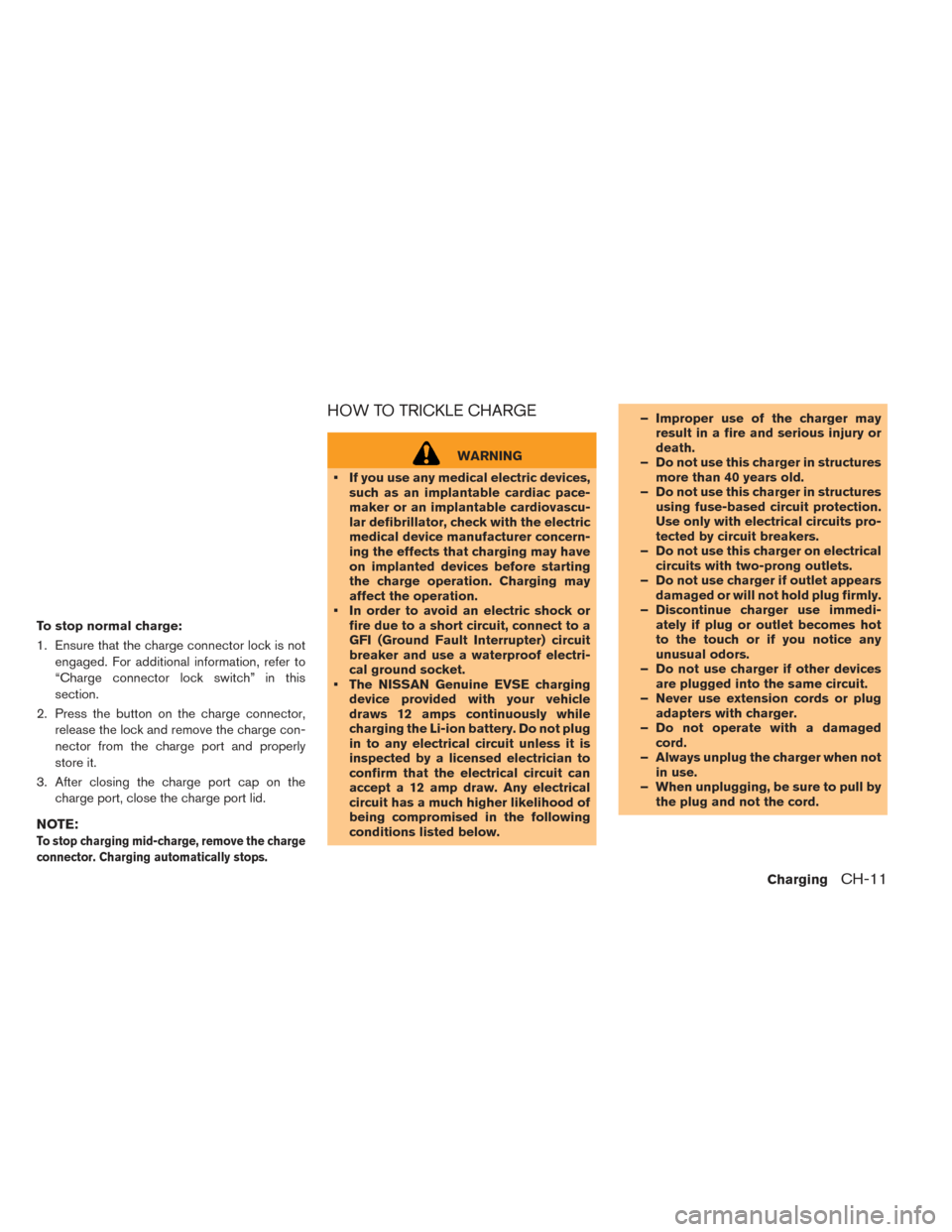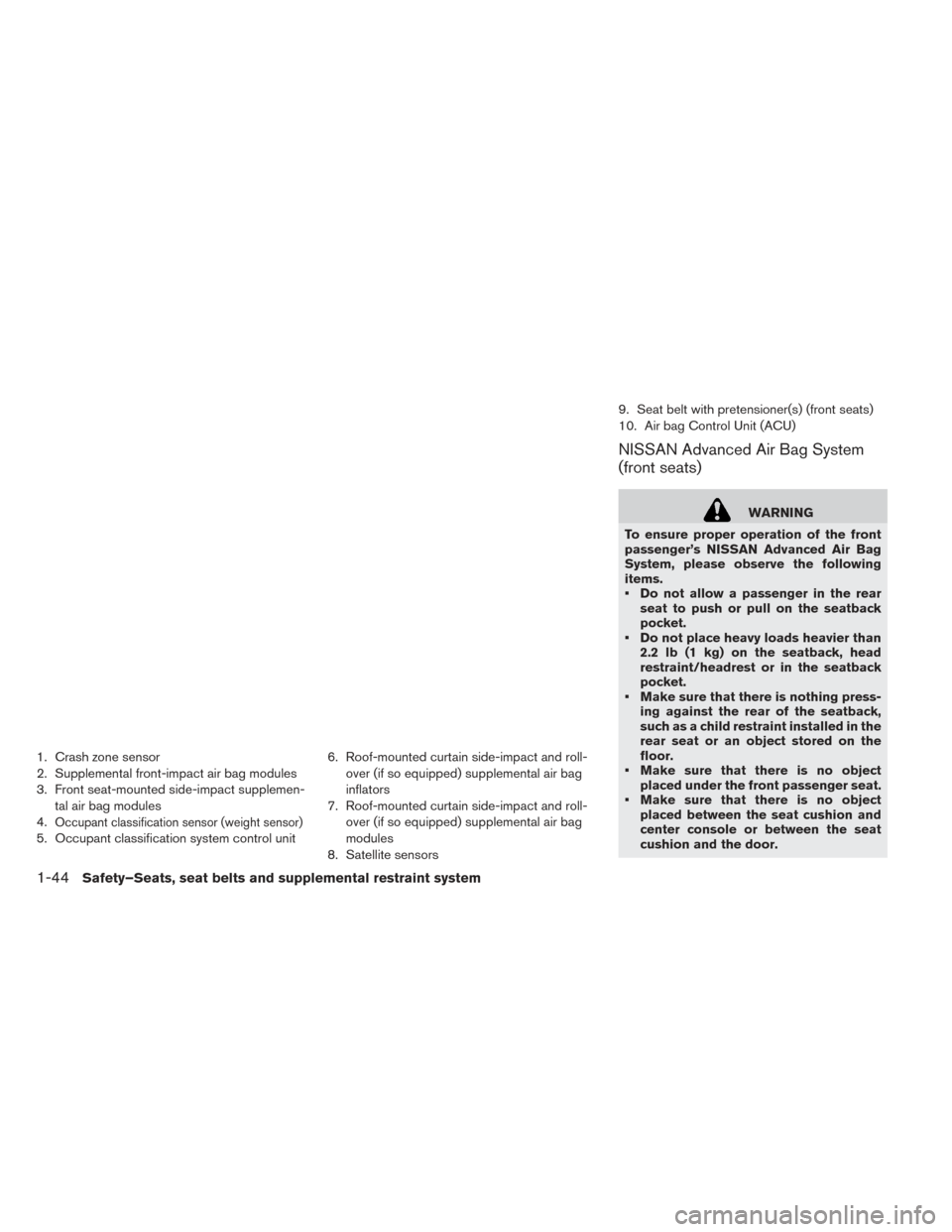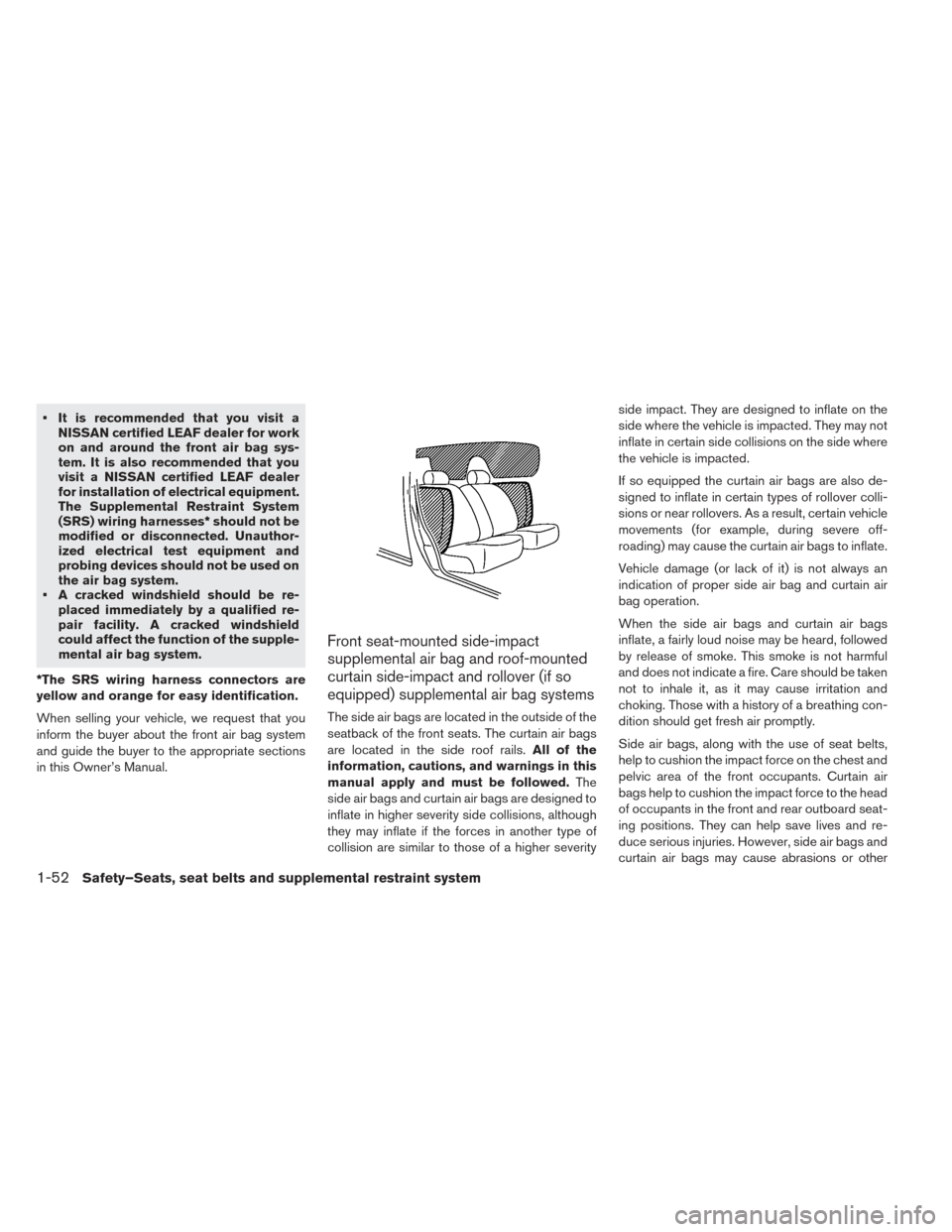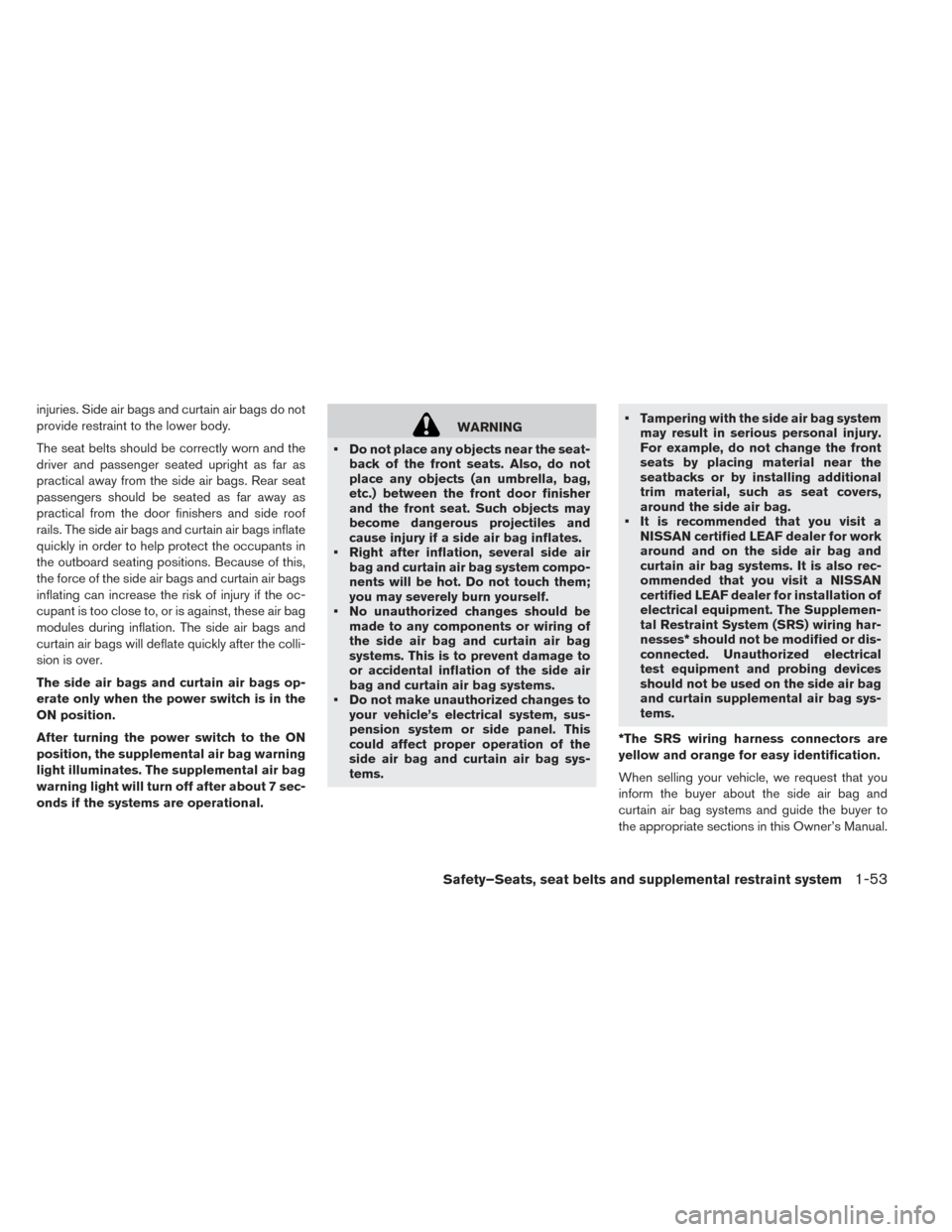2017 NISSAN LEAF roof
[x] Cancel search: roofPage 9 of 424

1. Rear head restraints/headrests (P. 1-5)
2. Child restraint anchor points (for top tetherstrap child restraint) (P. 1-18)
3. Roof-mounted curtain side-impact and roll- over (if so equipped) air bags (P. 1-39)
4. Front seat belt with pretensioner(s) and shoulder height adjuster (P. 1-8, 1-39)
5. Front head restraints/headrests (P. 1-5)
6. Front seats (P. 1-2)
7. Supplemental front-impact air bags (P. 1-39)
8. Front passenger air bag status light (P. 1-39)
9. Occupant classification sensor (weight sen- sor) (P. 1-39)
10. Front seat-mounted side-impact supple- mental air bags (P. 1-39)
11. Rear seats (P. 1-2)
12. LATCH (Lower Anchors and Tethers for CHildren) system (P. 1-18)
SEATS, SEAT BELTS AND
SUPPLEMENTAL RESTRAINT
SYSTEM (SRS)
0-2Illustrated table of contents
Page 60 of 424

To stop normal charge:
1. Ensure that the charge connector lock is notengaged. For additional information, refer to
“Charge connector lock switch” in this
section.
2. Press the button on the charge connector, release the lock and remove the charge con-
nector from the charge port and properly
store it.
3. After closing the charge port cap on the charge port, close the charge port lid.
NOTE:
To stop charging mid-charge, remove the charge
connector. Charging automatically stops.
HOW TO TRICKLE CHARGE
WARNING
• If you use any medical electric devices, such as an implantable cardiac pace-
maker or an implantable cardiovascu-
lar defibrillator, check with the electric
medical device manufacturer concern-
ing the effects that charging may have
on implanted devices before starting
the charge operation. Charging may
affect the operation.
• In order to avoid an electric shock or fire due to a short circuit, connect to a
GFI (Ground Fault Interrupter) circuit
breaker and use a waterproof electri-
cal ground socket.
• The NISSAN Genuine EVSE charging device provided with your vehicle
draws 12 amps continuously while
charging the Li-ion battery. Do not plug
in to any electrical circuit unless it is
inspected by a licensed electrician to
confirm that the electrical circuit can
accept a 12 amp draw. Any electrical
circuit has a much higher likelihood of
being compromised in the following
conditions listed below. – Improper use of the charger may
result in a fire and serious injury or
death.
– Do not use this charger in structures more than 40 years old.
– Do not use this charger in structures using fuse-based circuit protection.
Use only with electrical circuits pro-
tected by circuit breakers.
– Do not use this charger on electrical circuits with two-prong outlets.
– Do not use charger if outlet appears damaged or will not hold plug firmly.
– Discontinue charger use immedi- ately if plug or outlet becomes hot
to the touch or if you notice any
unusual odors.
– Do not use charger if other devices are plugged into the same circuit.
– Never use extension cords or plug adapters with charger.
– Do not operate with a damaged cord.
– Always unplug the charger when not in use.
– When unplugging, be sure to pull by the plug and not the cord.
ChargingCH-11
Page 122 of 424

PRECAUTIONS ON SRS
This SRS section contains important information
concerning the following systems.
• Driver and front passenger supplemental front-impact air bag (NISSAN Advanced Air Bag
System)
• Front seat-mounted side-impact supplemental air bag
• Roof-mounted curtain side-impact and rollover (if so equipped) supplemental air bag
• Seat belt with pretensioner(s) (front seats)
Supplemental front-impact air bag system
The NISSAN Advanced Air Bag System can help
cushion the impact force to the head and chest of
the driver and front passenger in certain frontal
collisions.
Front seat-mounted side-impact supple-
mental air bag system
This system can help cushion the impact force to
the chest and pelvic area of the driver and front
passenger in certain side impact collisions. The
side air bags are designed to inflate on the side
where the vehicle is impacted. Roof-mounted curtain side-impact and
rollover (if so equipped) supplemental air
bag system
This system can help cushion the impact force to
the head of occupants in front and rear outboard
seating positions in certain side impact collisions.
In a side impact, the curtain air bags are designed
to inflate on the side where the vehicle is im-
pacted. If so equipped, in a rollover, the curtain air
bags are designed to inflate and remain inflated
for a short time.
The SRS is designed to
supplementthe crash
protection provided by the driver and passenger
seat belts and is not a substitute for them. Seat
belts should always be correctly worn, and the
occupant should be seated a suitable distance
away from the steering wheel, instrument panel
and door finishers. For additional information,
instructions, and precautions on seat belt usage,
refer to “Seat belts” in this section. The supplemental air bags operate only
when the power switch is in the ON posi-
tion.
After the power switch is placed in the ON
position, the supplemental air bag warning
light illuminates. The supplemental air bag
warning light will turn off after about 7 sec-
onds if the system is operational.
SUPPLEMENTAL RESTRAINT
SYSTEM (SRS)
Safety–Seats, seat belts and supplemental restraint system1-39
Page 126 of 424

WARNING
Front seat-mounted side-impact supple-
mental air bags and roof-mounted cur-
tain side-impact and rollover (if so
equipped) supplemental air bags:
• The side air bags and curtain air bags ordinarily will not inflate in the event of
a frontal impact, rear impact, or lower
severity side collision. Always wear
your seat belts to help reduce the risk
or severity of injury in various kinds of
accidents. • The seat belts, the side air bags and
curtain air bags are most effective
when you are sitting well back and
upright in the seat. The side air bag
and curtain air bag inflate with great
force. Do not allow anyone to place
their hand, leg or face near the side air
bag on the side of the seatback of the
front seat or near the side roof rails. Do
not allow anyone sitting in the front
seats or rear outboard seats to extend
their hand out of the window or lean
against the door. Some examples of
dangerous riding positions are shown
in the previous illustrations.
• When sitting in the rear seat, do not hold onto the seatback of the front
seat. If the side air bag inflates, you
may be seriously injured. Be especially
careful with children, who should al-
ways be properly restrained. Some ex-
amples of dangerous riding positions
are shown in the illustrations.
• Do not use seat covers on the front seatbacks. They may interfere with
side air bag inflation.
Safety–Seats, seat belts and supplemental restraint system1-43
Page 127 of 424

1. Crash zone sensor
2. Supplemental front-impact air bag modules
3. Front seat-mounted side-impact supplemen-tal air bag modules
4.
Occupant classification sensor (weight sensor)
5. Occupant classification system control unit 6. Roof-mounted curtain side-impact and roll-
over (if so equipped) supplemental air bag
inflators
7. Roof-mounted curtain side-impact and roll- over (if so equipped) supplemental air bag
modules
8. Satellite sensors 9. Seat belt with pretensioner(s) (front seats)
10. Air bag Control Unit (ACU)
NISSAN Advanced Air Bag System
(front seats)
WARNING
To ensure proper operation of the front
passenger’s NISSAN Advanced Air Bag
System, please observe the following
items.
• Do not allow a passenger in the rear seat to push or pull on the seatback
pocket.
• Do not place heavy loads heavier than 2.2 lb (1 kg) on the seatback, head
restraint/headrest or in the seatback
pocket.
• Make sure that there is nothing press- ing against the rear of the seatback,
such as a child restraint installed in the
rear seat or an object stored on the
floor.
• Make sure that there is no object placed under the front passenger seat.
• Make sure that there is no object placed between the seat cushion and
center console or between the seat
cushion and the door.
1-44Safety–Seats, seat belts and supplemental restraint system
Page 135 of 424

• It is recommended that you visit aNISSAN certified LEAF dealer for work
on and around the front air bag sys-
tem. It is also recommended that you
visit a NISSAN certified LEAF dealer
for installation of electrical equipment.
The Supplemental Restraint System
(SRS) wiring harnesses* should not be
modified or disconnected. Unauthor-
ized electrical test equipment and
probing devices should not be used on
the air bag system.
• A cracked windshield should be re- placed immediately by a qualified re-
pair facility. A cracked windshield
could affect the function of the supple-
mental air bag system.
*The SRS wiring harness connectors are
yellow and orange for easy identification.
When selling your vehicle, we request that you
inform the buyer about the front air bag system
and guide the buyer to the appropriate sections
in this Owner’s Manual.
Front seat-mounted side-impact
supplemental air bag and roof-mounted
curtain side-impact and rollover (if so
equipped) supplemental air bag systems
The side air bags are located in the outside of the
seatback of the front seats. The curtain air bags
are located in the side roof rails. All of the
information, cautions, and warnings in this
manual apply and must be followed. The
side air bags and curtain air bags are designed to
inflate in higher severity side collisions, although
they may inflate if the forces in another type of
collision are similar to those of a higher severity side impact. They are designed to inflate on the
side where the vehicle is impacted. They may not
inflate in certain side collisions on the side where
the vehicle is impacted.
If so equipped the curtain air bags are also de-
signed to inflate in certain types of rollover colli-
sions or near rollovers. As a result, certain vehicle
movements (for example, during severe off-
roading) may cause the curtain air bags to inflate.
Vehicle damage (or lack of it) is not always an
indication of proper side air bag and curtain air
bag operation.
When the side air bags and curtain air bags
inflate, a fairly loud noise may be heard, followed
by release of smoke. This smoke is not harmful
and does not indicate a fire. Care should be taken
not to inhale it, as it may cause irritation and
choking. Those with a history of a breathing con-
dition should get fresh air promptly.
Side air bags, along with the use of seat belts,
help to cushion the impact force on the chest and
pelvic area of the front occupants. Curtain air
bags help to cushion the impact force to the head
of occupants in the front and rear outboard seat-
ing positions. They can help save lives and re-
duce serious injuries. However, side air bags and
curtain air bags may cause abrasions or other
1-52Safety–Seats, seat belts and supplemental restraint system
Page 136 of 424

injuries. Side air bags and curtain air bags do not
provide restraint to the lower body.
The seat belts should be correctly worn and the
driver and passenger seated upright as far as
practical away from the side air bags. Rear seat
passengers should be seated as far away as
practical from the door finishers and side roof
rails. The side air bags and curtain air bags inflate
quickly in order to help protect the occupants in
the outboard seating positions. Because of this,
the force of the side air bags and curtain air bags
inflating can increase the risk of injury if the oc-
cupant is too close to, or is against, these air bag
modules during inflation. The side air bags and
curtain air bags will deflate quickly after the colli-
sion is over.
The side air bags and curtain air bags op-
erate only when the power switch is in the
ON position.
After turning the power switch to the ON
position, the supplemental air bag warning
light illuminates. The supplemental air bag
warning light will turn off after about 7 sec-
onds if the systems are operational.
WARNING
• Do not place any objects near the seat- back of the front seats. Also, do not
place any objects (an umbrella, bag,
etc.) between the front door finisher
and the front seat. Such objects may
become dangerous projectiles and
cause injury if a side air bag inflates.
• Right after inflation, several side air bag and curtain air bag system compo-
nents will be hot. Do not touch them;
you may severely burn yourself.
• No unauthorized changes should be made to any components or wiring of
the side air bag and curtain air bag
systems. This is to prevent damage to
or accidental inflation of the side air
bag and curtain air bag systems.
• Do not make unauthorized changes to your vehicle’s electrical system, sus-
pension system or side panel. This
could affect proper operation of the
side air bag and curtain air bag sys-
tems. • Tampering with the side air bag system
may result in serious personal injury.
For example, do not change the front
seats by placing material near the
seatbacks or by installing additional
trim material, such as seat covers,
around the side air bag.
• It is recommended that you visit a NISSAN certified LEAF dealer for work
around and on the side air bag and
curtain air bag systems. It is also rec-
ommended that you visit a NISSAN
certified LEAF dealer for installation of
electrical equipment. The Supplemen-
tal Restraint System (SRS) wiring har-
nesses* should not be modified or dis-
connected. Unauthorized electrical
test equipment and probing devices
should not be used on the side air bag
and curtain supplemental air bag sys-
tems.
*The SRS wiring harness connectors are
yellow and orange for easy identification.
When selling your vehicle, we request that you
inform the buyer about the side air bag and
curtain air bag systems and guide the buyer to
the appropriate sections in this Owner’s Manual.
Safety–Seats, seat belts and supplemental restraint system1-53
Page 138 of 424

SUPPLEMENTAL AIR BAG
WARNING LABELS
A. Supplemental front-impact air bag system
warning labels
The warning labels are located on the surface of
the sun visors.
SUPPLEMENTAL AIR BAG
WARNING LIGHT
The supplemental air bag warning light, display-
ing
in the instrument panel, monitors the
circuits of the Air bag Control Unit (ACU) , satel-
lite sensors, crash zone sensor, occupant classi-
fication sensor, the supplemental front-impact air
bag, front seat-mounted side-impact supple-
mental air bag, roof-mounted curtain side-impact
supplemental air bag and seat belt pretensioner
systems. The monitored circuits include air bag
systems, pretensioner(s) and all related wiring. When the power switch is in the ON position, the
supplemental air bag warning light illuminates for
about 7 seconds and then turns off. This means
the system is operational.
If any of the following conditions occur, the front
air bag, side air bag, curtain air bag and preten-
sioner systems need servicing:
• The supplemental air bag warning light remains
on after approximately 7 seconds.
• The supplemental air bag warning light flashes intermittently.
• The supplemental air bag warning light does not come on at all.
Under these conditions, the front air bag, side air
bag, curtain air bag and pretensioner systems
may not operate properly. They must be checked
and repaired. It is recommended that you visit the
nearest NISSAN certified LEAF dealer for this
service.
Safety–Seats, seat belts and supplemental restraint system1-55